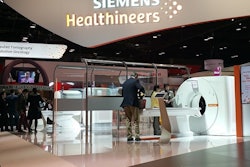
400 million. That's how many radiology studies (currents and priors) I can confirm have been processed and used for primary interpretation by U.S. imaging organizations operating within a deconstructed PACS strategy since April 2014, when "The time is now for deconstructed PACS" was published on AuntMinnie.com. While 400 million studies is a large number, it represents a mere fraction of the total number of studies, as I personally don't have visibility to all organizations using a deconstructed PACS strategy.
 Brad Levin of Visage Imaging.
Brad Levin of Visage Imaging.
Critics might say that a deconstructed PACS strategy is simply a best-of-breed, modular, or component-based approach to PACS that was once a go-to strategy in the early days of digital image management. All true. However, giving the strategy a catchy name got the industry talking and generated a level of excitement and optimism that hadn't been experienced in PACS for much of the prior decade.
Many of the largest imaging organizations in the U.S. have moved to or are planning a deconstructed PACS strategy, as many enterprises are running under legacy PACS networks that have aged to an average of 10 to 20 years. Those institutions that have not made a strategy decision have multiple alternatives to choose from, ranging from single to modular approaches; however, they are aware of the reality that their decision will need to future-proof their organization for the next decade and beyond.
The state of modular PACS solutions
Why have institutions chosen to implement modular PACS solutions? Because they were tired of underperforming software that failed to meet expectations, restricted advancement, and failed to keep up with changing enterprise demands in patient care at healthcare enterprises.
For example, the growing adoption of vendor-neutral archives (VNAs) is undeniable, and for many institutions this represents a move toward deconstruction. Over the past few years, the generally accepted basis for VNA has evolved, as many of the first movers have been acquired, a few vendors self-developed VNAs, and still other PACS archives were rebranded as VNAs.
Other institutions with challenges not sufficiently served by RIS- or PACS-driven workflow sought to deconstruct first with workflow engines. Some of these workflow engines were self-developed, others have been spun off into successful commercial products, and still others have been acquired by large vendors.
Workflow has also leapfrogged RIS-driven and PACS-driven approaches to ones driven by electronic health records (EHRs). Many integrated delivery networks (IDNs) have leadership mandates to maximize the value of their massive EHR investments and have embarked on EHR-driven workflow (for radiology, cardiology, and other specialties).
Still others have chosen to move forward with an enterprise viewing platform that could eliminate one or multiple viewers (e.g., diagnostic, clinical, breast imaging, 3D/advanced, specialty, mobile, or EHR) that have been poorly served by legacy PACS, delivering images faster and with more clinical capability and greater accuracy. Some organizations have chosen to move forward with one or more modular solutions, depending on organizational priorities and/or prior informatics investments.
'Best of need'
The total number of institutions invested in modular components is quite sizable. The reality is that imaging is sophisticated and can be quite complicated, and while many organizations share similar missions, each institution executes a local strategy. Instead of "best of breed," one could argue it's really "best of need."
There is no single approach for a deconstructed PACS strategy. Is a deconstructed PACS strategy the combination of a VNA + Workflow Solution + Enterprise Diagnostic Viewing Platform? Yes. Absolutely, it could be.
How about an EHR-driven Workflow + VNA + Enterprise Diagnostic Viewing Platform? Yes, indeed. What about Legacy PACS + VNA? You can make an argument that this, too, is a deconstructed PACS strategy.
Informed decision-making
The power of deconstruction lies in institutional empowerment, flexibility, and the results of tangible patient care improvements. The decision is not about the vendors involved in the final equation, it's the integrated solutions that together comprise the institution's path to enterprise imaging. The best approach comes from informed decisions based on proven systems that have been designed to work in an interoperable, multivendor environment.
All institutions are seeking the optimal combination to deliver the best possible interoperability, results, and performance, and the extent of deconstruction is up to the institution. Can all the components of a deconstructed PACS be supplied by one or multiple vendors? Absolutely, if the offered solutions are modular, truly open, and don't contribute to lock-in.
However, if the vendor(s) you are working with do not have a history of openness and have not proved their capabilities through a real-world proof of concept, it's reasonable to remain skeptical of their claims.
Real-world examples
Why is a modular strategy smart for today and the future of imaging? Here are real-world examples where modularization can help.
Innovation, not commoditization. Innovation comes in many flavors and doesn't wait. Many legacy PACS vendors stopped innovating, which accelerated PACS commoditization. PACS promoted as a single platform or an all-in-one solution -- without demonstrated support from the vendor to allow open, interoperable solutions -- may lock the institution into a long-term relationship that's difficult to unwind when the circumstances require change.
It's hard not to reflect on the past performance of many of these systems. For example, introducing add-on viewers to legacy platforms is not innovation. While on the surface it may appear that new viewers are progressive, these viewers add to support and operational complexity, and they mask the state of the underlying system architecture that continues to age.
For example, some legacy PACS diagnostic workstations do not have the necessary interoperability with VNAs and are unable to display prior imaging. In those circumstances, they require the use of adjunct clinical viewers to access prior imaging studies from the VNA. Is that innovation?
Keep your eye on the ball. I've met with many health systems that thought they were making the right choice by standardizing on a single vendor for PACS across their multilocation hospital systems. In many cases, this did not lead to the expected benefits of cross-location image sharing, remote reading, interoperability, performance gains, or institutional leverage to positively influence innovation. For example, if remote reading was a key attribute for improving radiologist productivity, as well as radiologist quality of life, the institution must ensure this is fully tested prior to selection.
The promise of next-generation gone bad. Generational leaps in technology often demo better than they work in production, and they may take years to mature into reliable solutions. When a vendor's legacy PACS is no longer an option due to significant performance and capability gaps, but its next-generation PACS is also not ready, institutional options quickly evaporate and a quagmire results. A modular strategy could offer more options, enabling the institutions to release themselves from imaging informatics purgatory.
The modular path
The schedule is blown, and the workflow/performance gaps are adding up. You've done your homework, you've made your selection(s), and you're deep in the implementation. Whether you've chosen one vendor for everything or multiple vendors, there's always a risk that the schedule and capabilities can't be met.
I know of multiple institutions that have gone both ways, and years after the request for proposal, they are still not fully live or, in some cases, not live at all. It's appalling how many recent installations I have come across that have outright failed, have been forced to roll back, or have been postponed or delayed with significant uncertainty for next steps.
Has your vendor oversold its capabilities, is your migration more challenging than anticipated, or is one of the components weaker than required? If your institution purchased an all-in-one solution, you may be stuck for the long haul with chronic buyer's remorse.
But if you chose a modular path, you may be able to quickly exit the poor-performing solution for a better option that allows you to stay on course to deliver the results and performance required.
Brad Levin is the general manager, North America, for Visage Imaging. He is a frequent industry speaker and author, with a more than 25-year imaging career spanning government, consulting, and commercial roles.
The comments and observations expressed are those of the author and do not necessarily reflect the opinions of AuntMinnie.com.



















